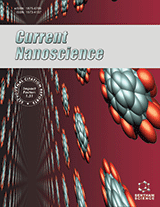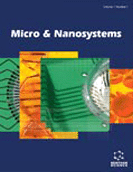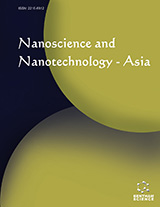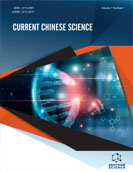Abstract
Background: Heterostructured nanocomposites have gained massive attention for their catalytic properties lately. A wide array of different visible-light-active photocatalysts (VLAPs) have been extensively studied over the past couple of years to fine-tune the bandgap of various stable semiconductors.
Objective: The current investigation reports the sensitization of TiO2 nanoparticles with nano-sized cuprous oxide, a well-studied p-type semiconductor, which has a relatively narrow bandgap ranging between 2.1 eV & 2.6 eV, to obtain a visible light active photocatalyst.
Methods: Visible-light-active Cu2O–TiO2 nanocomposite was synthesized using solvothermal technique. The nanocomposite’s structure and size properties were studied using powder diffraction (XRD), and electron microscopy (FESEM and HRTEM). Cu2O-TiO2 nanocomposite was tested on benzene, toluene and chlorobenzene in contaminated water, under UV and under visible light, for effective implementation in photocatalytic degradation of volatile organic contaminants.
Results: The said nanocomposite was crystalline and found to be 40–50 nm in size. No apparent change in the crystal lattice of TiO2 was observed due to the introduction of copper ion, and the nanocomposite also retained a high surface area of 76.28 m2/g. The efficiency of the Cu2O-TiO2 nanoparticles degradation was studied both under UV light and under visible. Cu2O-TiO2 nanoparticles achieved 97 – 99% degradation of benzene, 92 – 97% degradation of toluene and 95 – 98% degradation of chlorobenzene in water.
Conclusion: The said Cu2O–TiO2 nanocomposite is photo-active and showed an overall 95% degradation within 2 hours of treatment under the visible region.
Keywords: Cu2O–TiO2 nanocomposite, visible light active photocatalyst, bandgap fine-tuning, volatile organic contaminants, degradation of benzene and its derivatives, environmental remediation.
Graphical Abstract
Current Nanoscience
Title:Cu2O-TiO2 Composite for Photocatalytic Degradation of Benzene and its Derivatives Using Visible Light
Volume: 17 Issue: 6
Author(s): Satya Vijaya Kumar Nune*Ravi Kumar Golimidi
Affiliation:
- Centre of Excellence (CoExAMMPC), Division of Chemistry, Department of Science & Humanities, Vignan’s Foundation for Science, Technology and Research (VFSTR), Guntur - 522213, AP,India
Keywords: Cu2O–TiO2 nanocomposite, visible light active photocatalyst, bandgap fine-tuning, volatile organic contaminants, degradation of benzene and its derivatives, environmental remediation.
Abstract:
Background: Heterostructured nanocomposites have gained massive attention for their catalytic properties lately. A wide array of different visible-light-active photocatalysts (VLAPs) have been extensively studied over the past couple of years to fine-tune the bandgap of various stable semiconductors.
Objective: The current investigation reports the sensitization of TiO2 nanoparticles with nano-sized cuprous oxide, a well-studied p-type semiconductor, which has a relatively narrow bandgap ranging between 2.1 eV & 2.6 eV, to obtain a visible light active photocatalyst.
Methods: Visible-light-active Cu2O–TiO2 nanocomposite was synthesized using solvothermal technique. The nanocomposite’s structure and size properties were studied using powder diffraction (XRD), and electron microscopy (FESEM and HRTEM). Cu2O-TiO2 nanocomposite was tested on benzene, toluene and chlorobenzene in contaminated water, under UV and under visible light, for effective implementation in photocatalytic degradation of volatile organic contaminants.
Results: The said nanocomposite was crystalline and found to be 40–50 nm in size. No apparent change in the crystal lattice of TiO2 was observed due to the introduction of copper ion, and the nanocomposite also retained a high surface area of 76.28 m2/g. The efficiency of the Cu2O-TiO2 nanoparticles degradation was studied both under UV light and under visible. Cu2O-TiO2 nanoparticles achieved 97 – 99% degradation of benzene, 92 – 97% degradation of toluene and 95 – 98% degradation of chlorobenzene in water.
Conclusion: The said Cu2O–TiO2 nanocomposite is photo-active and showed an overall 95% degradation within 2 hours of treatment under the visible region.
Export Options
About this article
Cite this article as:
Nune Vijaya Kumar Satya *, Golimidi Kumar Ravi, Cu2O-TiO2 Composite for Photocatalytic Degradation of Benzene and its Derivatives Using Visible Light, Current Nanoscience 2021; 17 (6) . https://dx.doi.org/10.2174/1573413717666210127102749
| DOI https://dx.doi.org/10.2174/1573413717666210127102749 |
Print ISSN 1573-4137 |
| Publisher Name Bentham Science Publisher |
Online ISSN 1875-6786 |
 4
4
- Author Guidelines
- Bentham Author Support Services (BASS)
- Graphical Abstracts
- Fabricating and Stating False Information
- Research Misconduct
- Post Publication Discussions and Corrections
- Publishing Ethics and Rectitude
- Increase Visibility of Your Article
- Archiving Policies
- Peer Review Workflow
- Order Your Article Before Print
- Promote Your Article
- Manuscript Transfer Facility
- Editorial Policies
- Allegations from Whistleblowers























